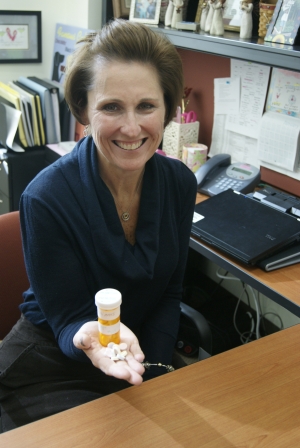Turning the tables on prescribers

Clinical instructor Kelly Nestor MSN, ANP-BC “prescribed” nurse practitioner students a candy medicine schedule for 10 days. “It was to raise their consciousness about necessary prescribing and choosing medications that are easy to take and to encourage patient adherence if it’s truly needed,” she explains.
“Candy” pills raise awareness of future nurse practitioners
Usually talking about medicine and candy together can be a dangerous thing, but in the case of nurse practitioner (NP) education at Villanova’s College of Nursing, it’s used to promote safety. As part of the clinical management in primary care course for pediatric, adult and family NP students, clinical instructor Kelly Nestor MSN, ANP-BC gave the future prescribers a unique assignment.
Using a clean pill bottle for each student, Nestor affixed a label with a student's name and filled it with 60 pieces of small pill-shaped candy. The students were given instructions that they were to take 2 "pills" every eight hours for 10 days. NPs are prescribers who have detailed knowledge of how drugs work in the body, specific dosages for different conditions, and potential threatening interactions, for example, but may not have a good understanding of the lived experience of taking multiple drugs ("polypharmacy") for their patients—young or old.
The assignment kicked off the spring semester after the students listened to several hours of lecture about prescribing and antibiotics, as well as polypharmacology and how it can be very easy to add medications, sometimes to acutely treat or counteract something else. This is not unusual. Nestor notes, "The average American over 60 is on six to eight prescription medications and may also be taking over-the-counter medications such as calcium, multivitamins, aspirin or fish oil.”
Nestor is quick to add that not only do older patients have to deal with multiple medications, but so do the stressed parents of ill children. Poor adherence to a drug regimen can occur at any age. Prescribers such as NPs can have an impact on patient safety by prescribing drugs that are easier for patients to take, being aware of the entire collection of drugs that a patient ingests and interviewing them or their family members about adherence to the plan.
Students were intrigued but not looking forward to the task. Nestor recalls, “They bargained with ‘How about two times a day? Really, 10 days? Can I take them all at once?" which prompted the conversation about how drugs work and therapeutic blood levels of drugs. The NP students were asked to bring the bottles back the following week for class to share how they were doing. The results? “A few said they were able to take the fake pills for a couple days and then they went by the wayside. Another found them on her desk that morning,” says Nestor. “They all agree that while they weren't good at taking the ‘pills’ it opened their eyes to the real problem of medication scheduling. When considering adding a medication to a person's existing schedule, they know they really need to think long and hard about timing--are they taking other meds at the same time and are they setting up the patient for failure.”
Failure is common. According to the Centers for Disease Control, 700,000 emergency department visits and 120,000 hospitalizations are due to adverse drug events annually. While these statistics include emergencies for reasons other than polypharmacy, the numbers are significant. “I tell the students all the time that some of us can't remember to take a multivitamin every day,” offers Nestor, “so what stresses are we adding to our patients lives asking them to try to remember to medications 2,3,4 times a day?”
